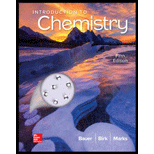
(a)
Interpretation:
On increasing the concentration of the reactant, the average energy of collision increases or not is to be identified.
(b)
Interpretation:
On increasing the concentration of reactant, the collision frequency increases or not is to be identified.
(c)
Interpretation:
On increasing the concentration of reactant, the fraction of collisions with proper molecular orientation increases or not is to be identified.
Explanation:
With an increase in the concentration of reactant, the number of molecules colliding increases and the space between these molecules decreases. Hence, the possibility of molecules colliding increases, which leads to an increase in the collision frequency. However, there is no increase in the fraction of molecules with proper orientation because there is no increase in the kinetic energy or temperature.
(d)
Interpretation:
On increasing the concentration of reactant, the fraction of collision with sufficient energy increases or not is to be identified.
Explanation:
With an increase in the concentration of reactant, the number of molecules colliding increases and the space between these molecules decreases. Hence, the possibility of molecules colliding increases. As the collision increases, the energy of molecules increases and molecules start colliding with sufficient energy to overcome the activation energy.
(e)
Interpretation:
On increasing the concentration of reactant, the reaction rate increases or not is to be identified.
Explanation:
With an increase in the concentration of reactant, the number of molecules colliding increases and the space between these molecules decreases. Hence, the possibility of molecules colliding increases. As the collision increases, the energy of molecules increases and molecules start colliding with sufficient energy to overcome the activation energy and more reactants get converted into products. This leads to an increase in the
(d)
Interpretation:
On increasing the concentration of reactant, the fraction of collision with sufficient energy increases or not is to be identified.
(e)
Interpretation:
On increasing the concentration of reactant, the reaction rate increases or not is to be identified.
Want to see the full answer?
Check out a sample textbook solution
Chapter 12 Solutions
INTRODUCTION TO CHEMISTRY(LL)-W/CONNECT
- (c) SOCI Best Lewis Structure 2 e group arrangement: shape/molecular geometry:_ (d) PCls Best Lewis Structure polarity: e group geometry:_ shape/molecular geometry:_ (e) Ba(BrO2): Best Lewis Structure polarity: e group arrangement: shape/molecular geometry: polarity: Sketch (with angles): Sketch (with angles): Sketch (with angles):arrow_forwardDon't used Ai solutionarrow_forwardDon't used Ai solutionarrow_forward
- reaction scheme for C39H4202 Hydrogenation of Alkyne (Alkyne to Alkene) show reaction (drawing) pleasearrow_forwardGive detailed mechanism Solution with explanation needed. Don't give Ai generated solutionarrow_forwardShow work with explanation needed....don't give Ai generated solutionarrow_forward
 Introductory Chemistry: An Active Learning Approa...ChemistryISBN:9781305079250Author:Mark S. Cracolice, Ed PetersPublisher:Cengage Learning
Introductory Chemistry: An Active Learning Approa...ChemistryISBN:9781305079250Author:Mark S. Cracolice, Ed PetersPublisher:Cengage Learning World of Chemistry, 3rd editionChemistryISBN:9781133109655Author:Steven S. Zumdahl, Susan L. Zumdahl, Donald J. DeCostePublisher:Brooks / Cole / Cengage Learning
World of Chemistry, 3rd editionChemistryISBN:9781133109655Author:Steven S. Zumdahl, Susan L. Zumdahl, Donald J. DeCostePublisher:Brooks / Cole / Cengage Learning General, Organic, and Biological ChemistryChemistryISBN:9781285853918Author:H. Stephen StokerPublisher:Cengage Learning
General, Organic, and Biological ChemistryChemistryISBN:9781285853918Author:H. Stephen StokerPublisher:Cengage Learning- Chemistry: Matter and ChangeChemistryISBN:9780078746376Author:Dinah Zike, Laurel Dingrando, Nicholas Hainen, Cheryl WistromPublisher:Glencoe/McGraw-Hill School Pub Co
 Chemistry for Today: General, Organic, and Bioche...ChemistryISBN:9781305960060Author:Spencer L. Seager, Michael R. Slabaugh, Maren S. HansenPublisher:Cengage Learning
Chemistry for Today: General, Organic, and Bioche...ChemistryISBN:9781305960060Author:Spencer L. Seager, Michael R. Slabaugh, Maren S. HansenPublisher:Cengage Learning





